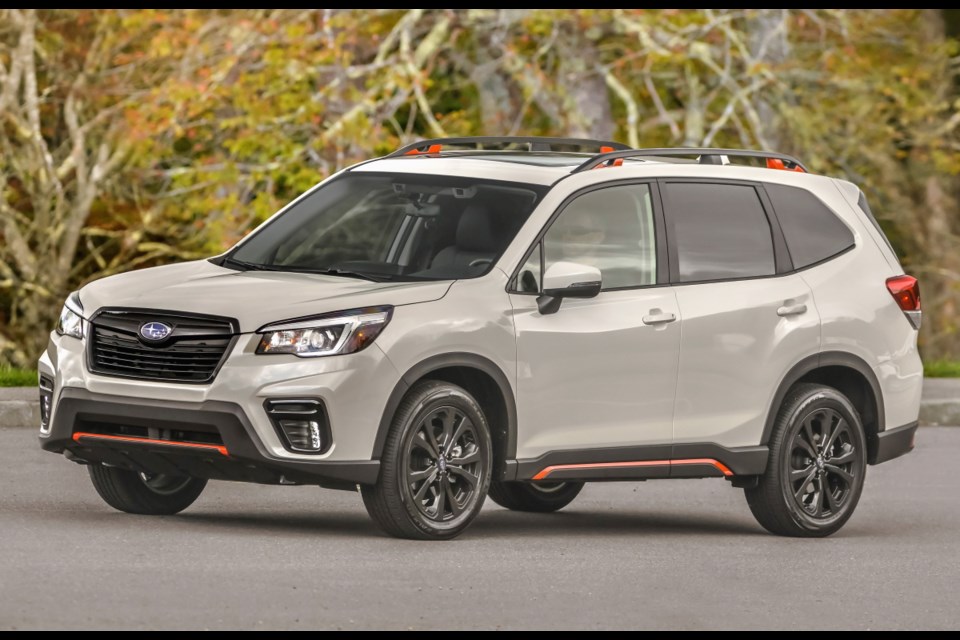The battle for the wallets of buyers of compact SUVs just got ratcheted up a notch with the introduction of the 2019 Subaru Forester.
Canadians have embraced SUVs in recent years, and the compact-size segment in particular has seen the fiercest competition.
You can’t just be good, you have to be better than your rivals to survive here. Choices facing the consumer include the Toyota RAV4, Honda CR-V, Mazda CX-5, Hyundai Tucson, Ford Escape, Nissan Rogue, Chevrolet Equinox and others.
It’s into this market that the 2019 Forester confidently strides. This is the Forester’s fifth generation, and Subaru has had 22 years to refine its offering.
The 2019 Forester comes in nine configurations, starting at $27,995 for the 2.5i model. I drove the top-of-the-line Premier, which has a list price of $39,495.
The 2019 is practically all-new, says Subaru, with almost no carryover components from last year’s car. While I believe it, a glance at the two parked side by side shows a strong resemblance to each other.
I guess you can’t fault Subaru for adhering to the old adage: “If it ain’t broke, don’t fix it.”
Subaru says the new global platform the 2019 rides on is stiffer than the one it replaces.
It is marginally longer than some of the competition, but surprisingly it is not wider. Many manufacturers have increased the width of their vehicles recently to squeeze out more interior volume.
The reason the Forester has managed to stay trim comes down to packaging. Consider the fact that even though the Honda CR-V is 136 millimetres wider, the Forester has 3,053 litres of passenger volume — 176 more than the Honda.
There are changes under the hood. Gone is the XT variant, with its more powerful turbocharged 2.0-litre engine.
The only powertrain available is a 2.5-litre horizontally opposed four-cylinder. Although it shares the same displacement as last year’s engine, Subaru says it is 90 per cent new.
Engineers have managed to bump up horsepower to 182 — 12 more than last year. Torque is also up by two pound-feet, but at 4,400 rpm, 400 rpm higher than before.
The 2019 has put on some weight, about 92 kilograms more, so despite the extra power, the new vehicle feels about the same in acceleration. That’s not to say the Forester was a speed demon to begin with. Acceleration is adequate for merging and passing, but it won’t set the pulse quickening.
The main differentiation between the Forester and all of its competitors is that all-wheel drive is standard in all models, with no front-wheel-drive offerings.
For sa���ʴ�ý, that makes it a definite plus if you plan to travel in the winter or if you actually take your Forester off-road.
Subaru equips all Foresters with what they call X-Mode, a drive setting optimized for serious off-roading, including a hill-descent mode.
On higher trim levels, such as the Sport, Limited and Premier, the Forester gets what Subaru calls Dual-Mode, in which you can select snow/dirt or deep snow/mud, which disengages the traction control to optimize the best torque for road (or lack thereof) conditions.
For those who enjoy graphics, there is a colour display showing the vehicle’s angle of approach and departure as well as the degree of tilt side-to-side — in real time. The display also shows snow or sand terrain in the simulated image (if you need a reminder of what you see outside the windows).
A manual transmission is no longer offered. All Foresters are now equipped with a continuously variable transmission with simulated gears shifting in manual mode.
The Forester’s maximum towing capacity is listed at 680 kilograms.
Subaru has taken the high road in regards to safety. All except the base model can be equipped with their Eyesight driver-assist technology, which includes pre-collision braking, lane-departure warning, lane-keep assist and adaptive cruise control. The system also features reverse automatic braking, where the brakes are applied if the vehicle senses there is an object in its path.
On the Premier trim, Subaru equips the Forester with a driver-distraction mitigation system. A camera angled at the driver uses facial-recognition technology to monitor fatigue or lack of attention. If it detects a driver nodding off, it sounds an alarm. It can store preferences for up to five drivers.
Driver-inattention systems have been up until now only been found on high-end Mercedes-Benz and BMW vehicles. This is the first application in a non-luxury brand, and represents trickle-down technology at its best.
In a packed market, the 2019 Subaru Forester manages to stand out from the crowd with ease thanks to its suite of technological and safety features. While it might never gain the quantitative numbers by Ford, Toyota or Honda, this new model is sure to satisfy its base of loyal fans and attract new converts.
THE SPEC SHEET
Type: Compact SUV, front engine, all-wheel-drive
Engine: 2.5-litre, horizontally-opposed four-cylinder engine, 182 hp at 5,800 r.p.m., 176 lb.-ft. of torque at 4,400 r.p.m.
Transmission: CVT
Dimensions (mm): Length, 4,625; width, 1,815; height (with roof rails), 1,730; wheelbase, 2,670
Curb weight (kg): 1,630
Price (base/as tested): $39,495/ $41,320 (includes $1,725 freight and PDI and $100 AC tax)
Options: Nil
Tires: 225/55 R19
Fuel type: Regular
Fuel economy (L/100km): 9.0 city/ 7.2 highway
Warranty: Three years/60,000 km new car, five years/100,000 km major component



